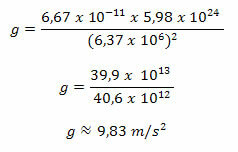the force of gravity  that acts on a mass in a certain region is related to the gravitational field produced by the Earth in that location.
that acts on a mass in a certain region is related to the gravitational field produced by the Earth in that location.

Thus, the magnitude of the gravitational field can be defined as the quotient between the gravitational force and the mass of the object.

Using the expression of the law of universal gravitation and the expression of the force weight,

it is possible to calculate the magnitude of the gravitational field on the Earth's surface, even without putting a mass on it, and measure its weight.

In both expressions, the letter m represents the mass of the object placed on the Earth's surface. Simplifying m, we get the expression of the gravitational field value.

Substituting the values of G, M (Earth mass) and r (Earth radius), we have:

In summary, the gravitational field is a way of describing the interaction between objects due to their masses. O gravitational field module is calculated by the quotient of the gravitational force (or by multiplying the universal gravitational constant by the mass of the planet), divided by the distance from the point where you want to know the field to the center of the planet, raised to the square.
gravitational and inertial mass
We can only measure the mass of a body with a scale in places where we can also measure the weight, because the gravitational force is what produces the imbalance in the scale.
The mass obtained through the gravitational force is called gravitational mass. However, this is not the only way to obtain the mass value. When a force acts on a body, Newton's second law equation (F = m.a) can be used.
Based on this equation, we can then obtain the mass of a body by making the quotient between force and acceleration. Conceptually, this other way of measuring mass is somewhat different from using a scale and, therefore, it is called another way: inertial mass.
Thus, we say that the inertial mass is referring to the difficulty of producing movement in a body, that is, of varying its speed. It is worth remembering that conceptually the masses are different, but the values found, in both ways, can be the same.
By Domitiano Marques
Graduated in Physics
Source: Brazil School - https://brasilescola.uol.com.br/fisica/o-valor-campo-gravitacional.htm


